Who’s Got Affinity
How can advanced computing accelerate cures for complex diseases such as Alzheimer’s and cancer? What breakthroughs in quantum mechanics will allow us to solve complex problems in medicine, energy and materials science faster than ever before? When tackling society’s big challenges — from cybersecurity and climate change to drug discovery and mental health — the whole is undoubtedly greater than the sum of its parts.
That’s why the USC School of Advanced Computing (SAC), a unit of the USC Viterbi School of Engineering, is launching “Advanced Computing Affinity Groups,” uniting faculty from wide-ranging disciplines across USC’s 23 schools, from the arts to social sciences to security to health and medicine.
To support the initiative, a recent $10 million gift from Andrew Viterbi (see page 54), the pioneering electrical engineer and inventor of the Viterbi algorithm, will fund the hiring of new faculty at these intersections of advanced computing and other academic disciplines. The money will support the recruitment of new distinguished chairs, attracting top-tier faculty talent to catalyze the next big scientific discoveries.
1
Computational Medicine and Health
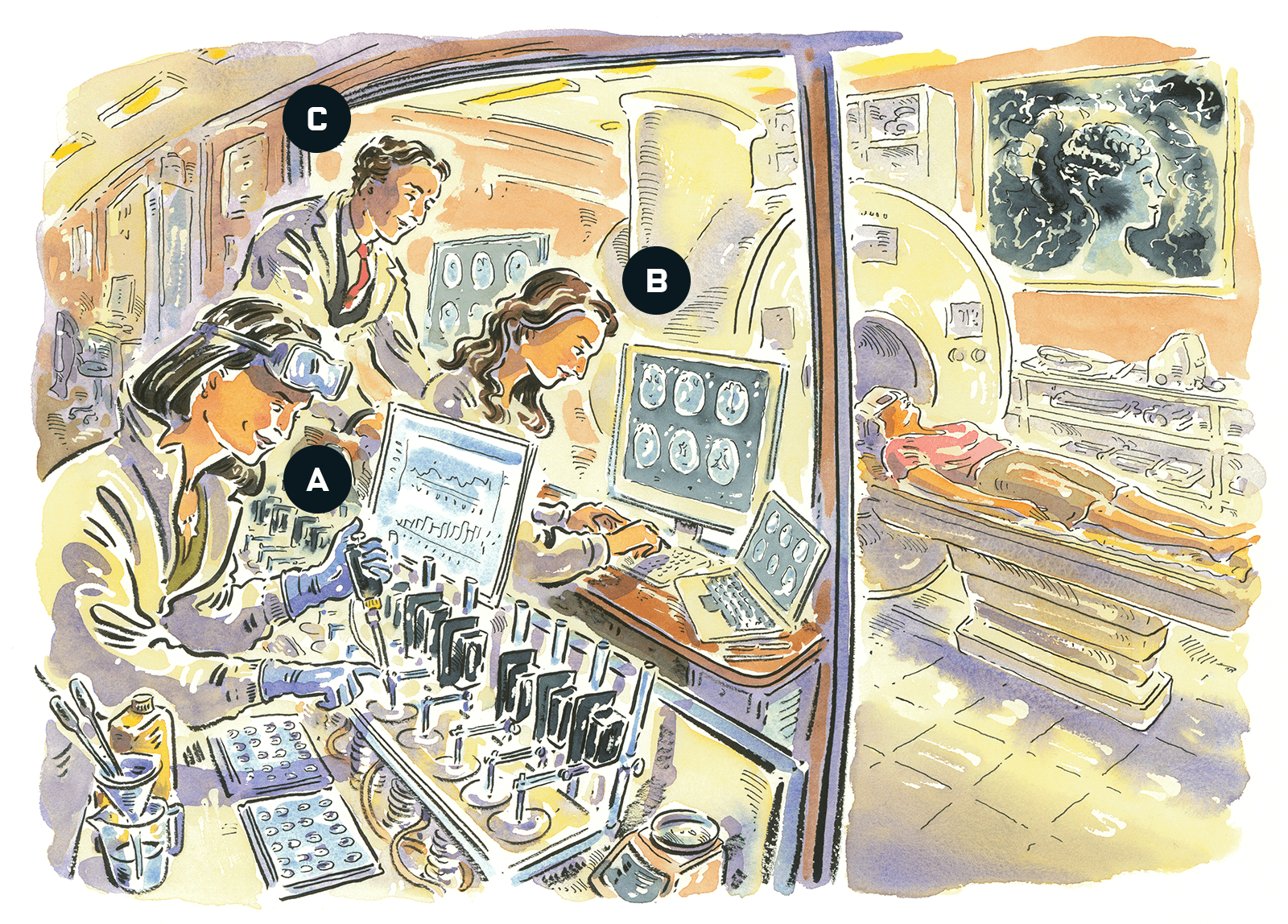
A) Gauri Rao, Associate Professor of Clinical Pharmacy and Director of the Quantitative Drug and Disease Modeling Center, Titus Family Department of Clinical Pharmacy (USC Mann)
“Computing is essential in all aspects of medicine, starting with drug development. Various computational approaches are used for computer-aided drug design and in silico mechanism-based modeling, from the preclinical to clinical phases. These methods provide better insights into pharmacokinetics (how the body processes the drug) and pharmacodynamics (how the drug affects the body once it reaches its target site), helping to design optimized dosing regimens for translation to the clinic. Next, population modeling using clinical trial data helps us gain insights into interindividual variability in drug exposure and activity, acknowledging that one dose does not fit all.”
As a clinically oriented researcher with an engineering background, she has developed a research program focused on addressing antimicrobial resistance (AMR). By integrating in vitro and in vivo infection models with in silico mathematical models, this approach aims to enhance our understanding of the interactions between bacterial pathogens, the host and antibiotic treatments throughout the infection process. Leveraging clinical insights about infections, this systems-based approach has enabled Rao’s lab to discover two promising drugs that could significantly aid in combating AMR.
B) Maryam Shanechi, Professor of Electrical and Computer Engineering, Biomedical Engineering, and Computer Science; Founding Director of the USC Center for Neurotechnology (USC Viterbi)
“In my research, we need to decode internal brain states, such as mood, or behavorial states, such as movements from complex brain signals. Modeling and decoding these complex brain signals require significant innovation in computing to develop novel AI/ML algorithms that can describe these complex signals and extract hidden information from them. This can lead to transformative brain-computer interfaces. We have also modeled the effect of deep brain stimulation on brain activity and mental states by developing new computing algorithms.”
Shanechi and her group are developing an entirely new generation of brain-computer interfaces that can transform treatments for diverse brain disorders, such as major depression, which are a leading cause of disability worldwide. They do so by modeling, decoding and regulating abnormal brain activity patterns in these disorders. They have made significant progress by achieving the first decoding of mood from human brain activity, by modeling the effect of brain stimulation therapy on brain activity, and by developing an AI algorithm that can substantially improve the modeling and decoding of diverse brain states.
C) Paul Thompson, Professor of Ophthalmology, Pediatrics, Neurology, Psychiatry and the Behavioral Sciences, Radiology, Biomedical Engineering and Electrical Engineering (USC Keck)
“Deep learning methods allow us to predict clinical decline and discover genomic markers associated with Alzheimer’s. These AI models are over 90% accurate in detecting Alzheimer’s from brain scans, a significant improvement from traditional methods.”
In 2019, Thompson and his team focused on identifying potential blood-based markers
for early Alzheimer’s detection by using machine learning. These methods can analyze vast amounts of neuroimaging data, genetic information and other biomarkers to predict disease
progression and identify early signs of Alzheimer’s disease with unprecedented accuracy. According to Thompson, one algorithm learned from reviewing more than 85,721 MRI scans from 50,876 patients, while another learned from poring over the 3 billion letters of the human genome to find signs of Alzheimer’s.
Thompson is the co-founder and director of the ENIGMA Consortium, a group of over 2,000 researchers in 45 countries dedicated to understanding brain structure and function, based on MRI, DTI, fMRI, genetic data and many patient populations.
2
Sustainability and Computation
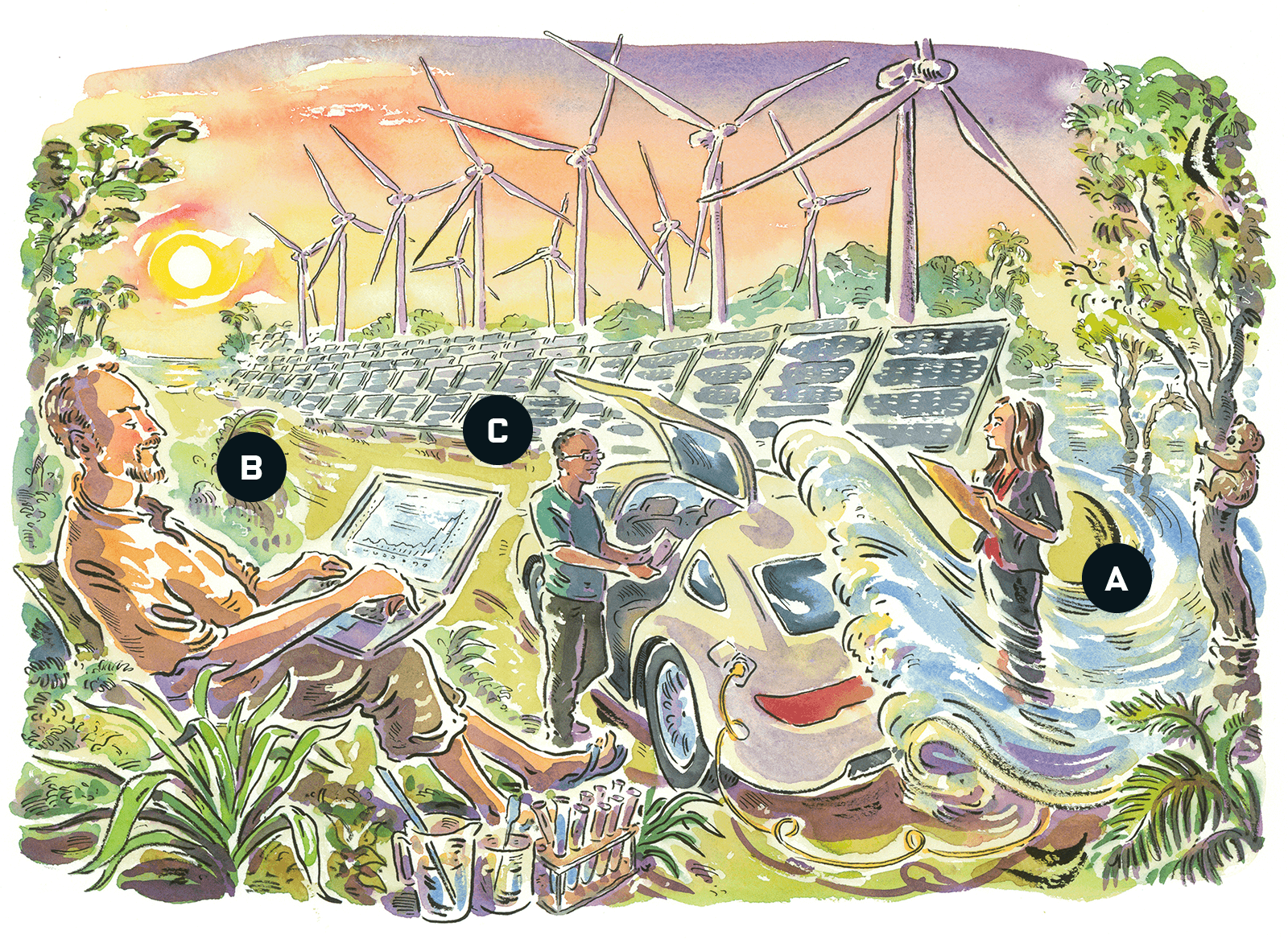
A) Naomi Levine, Associate Professor of Biological Sciences and Quantitative and Computational Biology (USC Dornsife)
“The oceans play a critical role in making the Earth a habitable planet. Specifically, microscopic organisms in the oceans (marine microbes) play a key role in the global carbon cycle and thus climate. They produce approximately half of all oxygen and act to cycle a pool of carbon that is equivalent to all the CO2 in the atmosphere. My research focuses on understanding how shifts in climate impact microbial systems and how to identify microbial systems in turn impact climate (ecosystem-to-climate feedback loops).”
“To do this, we develop innovative, interdisciplinary numerical models that provide new insight into how dynamics occurring at the scale of individual microbes impact large-scale ecosystem processes, such as rates of global carbon cycling. This leverages computational representations of cells, ecosystems and the oceans.”
She and her team have demonstrated that how individual bacteria interact with each other and organic matter they are degrading can play an important role in setting the transfer of carbon into the deep oceans. They also have shown that environmental fluctuations, driven by ocean physics, drive a trade-off between two evolutionary strategies that determine whether and how fast microbes can adapt to environmental change.
B) Julien Emile-Geay, Professor of Earth Sciences (USC Dornsife)
“Paleoclimatology, the study of past climate, uses archives like corals, tree rings, ice cores, mud from the bottom of lakes or oceans, and cave deposits to reconstruct past climate states. This, in turn, informs the fundamental dynamics of Earth’s climate, and informs future predictions, partly through the validation of physics-based models and/or training of AI systems. Because the field is data-driven, work is very time-consuming unless there are efficient workflows that can extract information from these very hard-won datasets, often requiring years of work for a few dozen data points. Computing is therefore essential to this work.”
His lab creates software and workflows to analyze, visualize and synthesize paleoclimate datasets, and uses them to constrain the workings of Earth’s climate.
He is most known for his work on the climate of the Common Era, and how El Niño-Southern Oscillation has varied in the past and what that means for its future.
C) Barath Raghavan, Associate Professor of Computer Science (USC Viterbi)
“As a society, we’ve turned to computing to solve all the important problems of modern life — sustainability among them. And as computing’s ecological footprint grows, it’s not only that computing can help address problems in societal sustainability, but making computing itself sustainable is a major challenge.”
He has worked on computing for sustainability (using computing to help address problems in agriculture, land use, power grids and more) and sustainable computing (making computing itself more sustainable) for 15 years.
Raghavan’s key accomplishments include:
- Performing the first comprehensive study of the total energy use of the internet
- Developing key conceptual frameworks for sustainable computing research, and organizing a workshop on the subject, now in its 10th year
- Developing computational agroecology, which is a new approach to computing-supported sustainable agriculture
- Developing new techniques, such as information batteries, to leverage computing to improve the use of sustainable energy on the grid
3
Computational Social and Behavioral Sciences
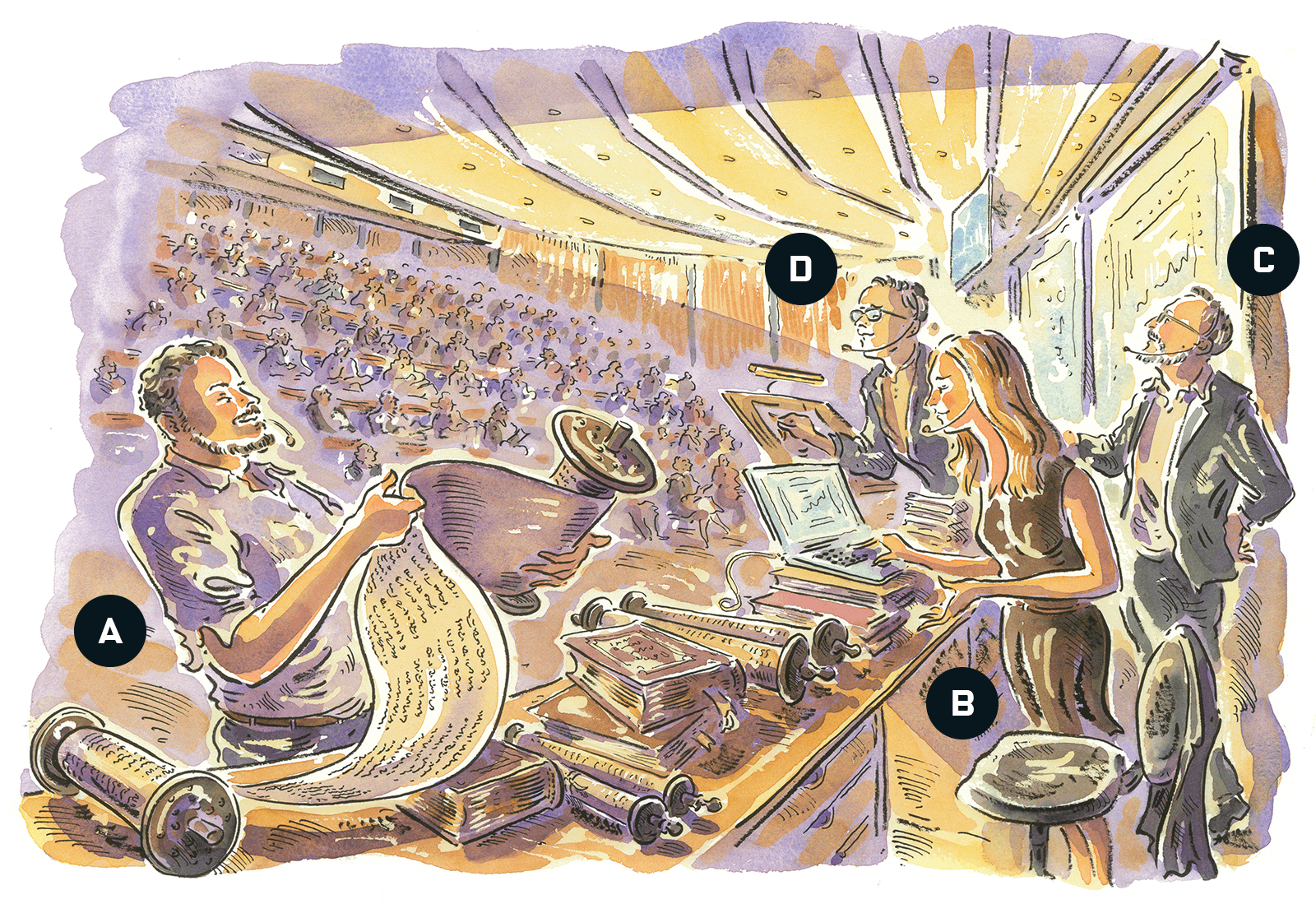
A) Kimon Drakopoulos, Associate Professor of Data Sciences and Operations (USC Marshall)
“Humanity has evolved for many years, and every disruption has brought replacement of jobs. We had exactly this conversation in the pre-industrial and industrial revolution phase. Sure, change is scary, and humanity has gone through phases of change many times and been successful. I don’t see why this would be so different.”
Drakopoulos’ research focuses on the operations of complex networked systems, social networks, stochastic modeling, game theory and information economics. He views computing through the lens of what it can achieve to improve human health, clarify understanding and solve pressing problems.
With Drakopoulos’ urging and assistance, Greek Prime Minister Kyriakos Mitsotakis has increasingly emphasized data science and artificial intelligence. Last year, the prime minister appointed several respected technologists, researchers, academics and policy experts to the country’s AI Advisory Committee. Drakopoulos was selected as an appointee.
B) Phebe Vayanos, Andrew and Erna Viterbi Early Career Chair and Associate Professor of Industrial and Systems Engineering and Computer Science (USC Viterbi)
“With advances in computing, and by integrating techniques from artificial intelligence (AI) and operations research (OR), we can help address some of the most pressing societal challenges of our time: to help end homelessness, to achieve equal opportunity and justice, to ensure healthy lives and to promote well-being for all.”
The USC Center for AI in Society advances knowledge in what “responsible and just AI” is by partnering with community stakeholders, organizations and policymakers. Projects involve interdisciplinary teams of computer scientists working alongside social work researchers to advance AI and OR in a direction that benefits vulnerable communities. One of our major achievements is the design, in partnership with LAHSA (the Los Angeles Homelessness Services Authority), of a tool for matching people experiencing homelessness to the city’s very scarce housing resources.
C) Khalil Iskarous, Associate Professor of Linguistics (USC Dornsife)
“Understanding how and why AI works as well as it does is essential for attempts at lowering its negative environmental costs. And scientific knowledge in fields like linguistics and psychology on how language works and is used for communication is an essential tool for sorting out what AI actually does.”
His work on preserving endangered languages lies at the intersection of linguistics, technology and cultural heritage, using computational models to analyze language patterns and contribute to their survival. Iskarous uses tools from dynamical systems analysis to understand information flows about language inside an LLM. He has also documented LLM-internal knowledge about the working of language.
D) Morteza Dehghani, Professor of Psychology and Computer Science (USC Dornsife)
“AI and social and behavioral sciences have a reciprocal relationship. Many core AI concepts and techniques (like LSTMs and RNNs) have their roots in these sciences. Even today, our understanding of human bias and decision-making informs how we identify and address bias in AI systems.
Conversely, computational tools for modeling, simulation and analysis have revolutionized social and behavioral sciences in the past decade. This two-way exchange will only deepen as computation and AI become more integral to social science research. At the same time, as AI systems become more sophisticated, they’ll increasingly need to incorporate insights from the social sciences to ensure they’re fair, unbiased and aligned with human values.”
His research integrates computing and social/behavioral sciences in two key ways: by incorporating cognitive science findings into NLP [natural language processing] systems and using NLP to uncover psychological processes in social discourse.
4
Computing and Security
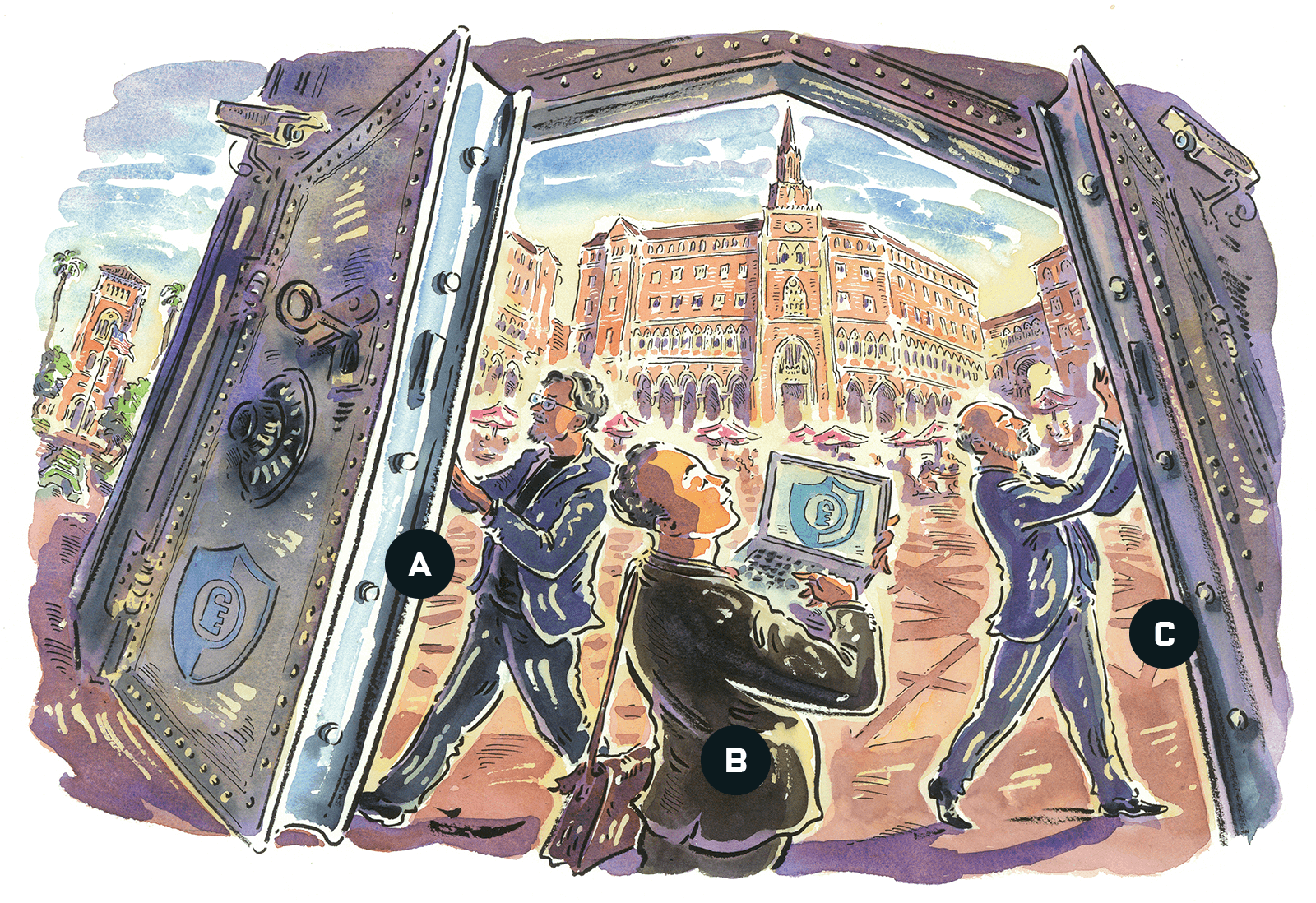
A) John P. Wilson, Professor of Architecture, Civil & Environmental Engineering, Computer Science, Population and Public Health Sciences, Sociology and Spatial Sciences (USC Dornsife)
“Human security and geospatial intelligence both focus on ‘what is where, when,’ and this information is used to assess risk and to guide interventions to protect lives and assets around the world.”
The digital era has brought a large number and variety of new data sources and streams that can be used to trace the movements of people and assets around the world, and we need spatial analysis and modeling, as well as advanced computing resources, to turn these data into actionable information.
Wilson and his team have launched undergraduate and master’s degrees in human security and geospatial intelligence. They propose using advanced computing to support spatial analysis and modeling to pinpoint hot spots that may lead to civil unrest and worse due to the changing climate and the consequences for different regions and nations.
B) Jonathan Choi, Professor of Law (USC Gould)
“Computing is crucial in allowing legal scholars to analyze large bodies of text, like regulatory documents or legal opinions. Because lawmakers produce new legal documents at such a fast pace, computational methods are the only way that we can make large-scale discoveries about trends in the law.”
Choi’s legal background helps him to identify policy-relevant questions, and computational methods provide the tools to find the right answers. Some of his current research includes evaluating the use of large language models on traditional empirical legal scholarship, demonstrating how to use ChatGPT to analyze legal documents and identifying best practices for the use of large language models in research.
In 2023, in a paper titled “ChatGPT Goes to Law School,” Choi and his co-authors found that AI models are rapidly improving, and, in some cases, can outperform real students on law school exam questions.
He has been one of the top 10 most-downloaded legal scholars worldwide. Choi has also won awards and accolades for his research applying computational methods to law. His work has been cited in court opinions and in the popular press by outlets like ABC, CBS, CNN, NBC, The New Yorker and USA Today.
C) Emilio Ferrara, Professor of Computer Science and Communication (USC Viterbi + Annenberg)
“Computing is essential to the field of security because it enables the development of advanced algorithms and systems capable of detecting, analyzing and mitigating threats in real time. It also allows for the integration of machine learning, data mining and artificial intelligence to predict and counteract sophisticated cyberattacks and information manipulation at scale.”
Ferrara has integrated computing with security by pioneering the use of graph-based models and machine learning to uncover information operations, such as disinformation campaigns and online manipulation. Notable accomplishments include his work on identifying botnets in social media ecosystems and developing methods to protect online information integrity, particularly in the context of elections and public discourse.
During the 2016 presidential election cycle, Ferrara’s analysis showed how automated bots were shaping political debates on social media — research that was later cited in federal investigations into Russian interference in that election.
5
Computational Science and Engineering
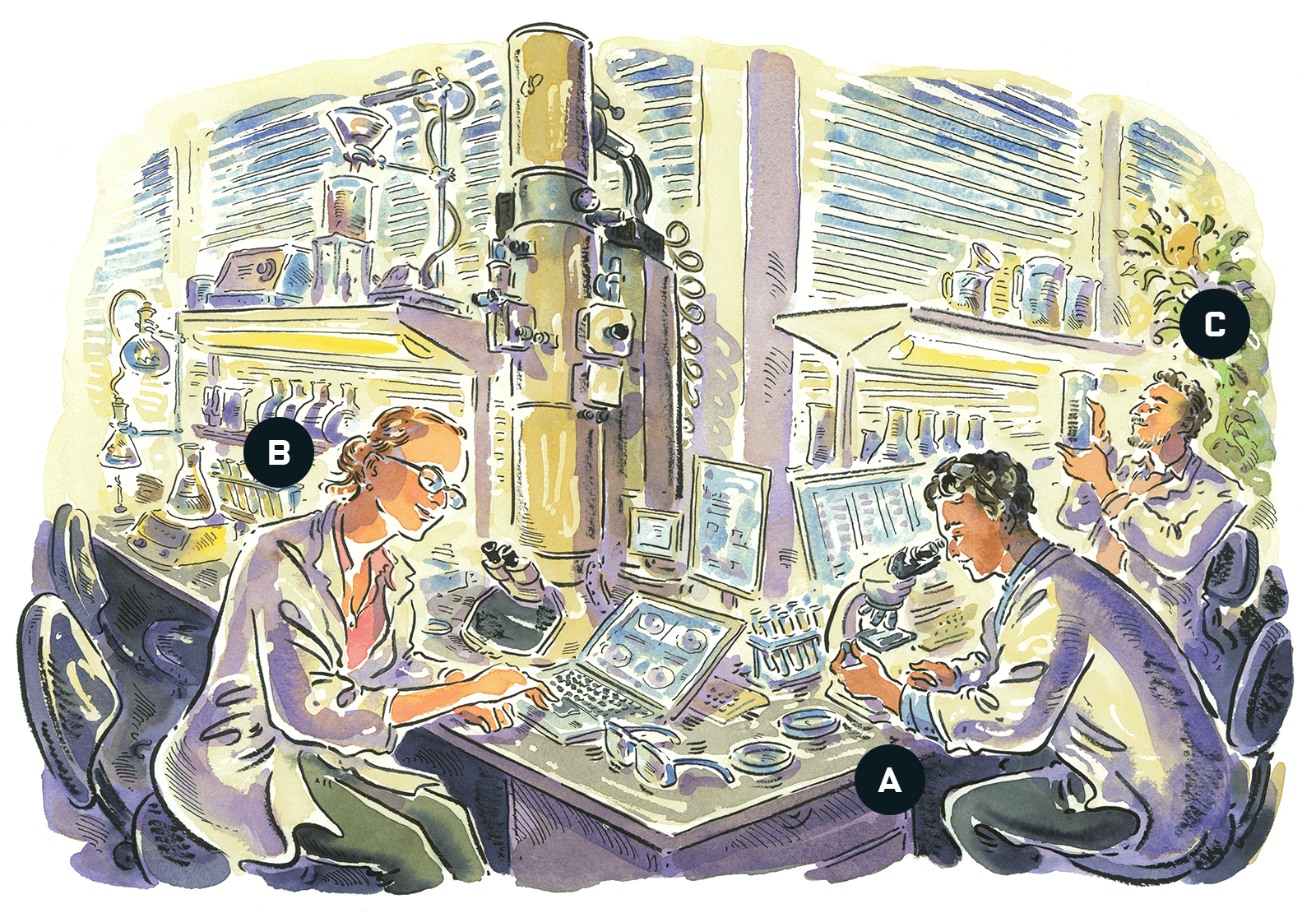
A) Krishna Garikipati, Professor of Aerospace and Mechanical Engineering (USC Viterbi)
“Computing is fundamental to making discoveries in much of the physical sciences. Certainly, this is true of biophysics and materials physics, which are disciplines that interest me.”
There are mathematical descriptions underpinning these fields that have a generality stretching far beyond a specific phenomenon. As an example, the dynamics governing the migration, proliferation and transition to cancerous behavior of cells are shared by swarms of animals, populations of humans and communities, and even the way opinions form and spread through society. Their mathematical complexity means that computation is often the only way to tease out the emergent phenomena in these systems. In turn, physics inspires the design of his computational methods.
Using computational and scientific machine learning methods, he and his team have discovered that when cells with cancerous potential are signaled to by certain non-cancerous stromal cells, they can organize themselves, forming patterns and transitioning to an aggressive, rapidly migrating and proliferating behavior. Yet wound healing by the same cancer cells happens mainly by their going on a disorganized, random walk. These results have important implications for understanding how tumors metastasize and spread to distant organs.
B) Anna Krylov, USC Associates Chair in Natural Sciences and Professor of Chemistry (USC Dornsife)
“In chemistry and physics, computing is an integral part of research. Quantum chemistry calculations connect experimental observations with a detailed atomistic picture of underlying processes. Such calculations are essential for deriving insight and advancing our understanding of molecules and materials.”
Krylov is developing new quantum chemistry approaches and computer codes for the description of electronically excited and open-shell species, including electronically metastable states. These methods are implemented in the Q-Chem software package, which is one of the leading codes for molecular simulations. Her group is also using these computer codes to investigate the role of radicals and electronically excited species in combustion, solar energy, bioimaging, spectroscopy and quantum information science.
Her important accomplishments include: development of spin-flip approach to strong correlation and extending coupled-cluster theory to spectroscopy modeling in high-energy and high-intensity regimes.
C) Vsevolod “Seva” Katritch, Professor of Quantitative and Computational Biology, Chemistry and Pharmacology and Pharmaceutical Sciences (USC Dornsife)
“My field of research concerns biochemistry and structural biology and their applications to the discovery of new therapeutic drugs. Computing, both physics-based molecular modeling and data-driven deep learning/AI, is the key to modern drug discovery, dramatically reducing its time and cost requirements and improving resulting therapies.”
His lab is purely computational and works in close collaboration with experimental labs that test his team’s predictions. Most notably, Katritch’s group has developed V-SYNTHES — a new computational approach to screening chemical spaces of billions of compounds for new drug candidates. This technology, now with a deep learning accelerator module, has become a core platform for the CNT3D center, where his team collaborates across USC and around the globe to facilitate early drug discovery for clinically relevant targets.
6
Arts, Humanities and Computing
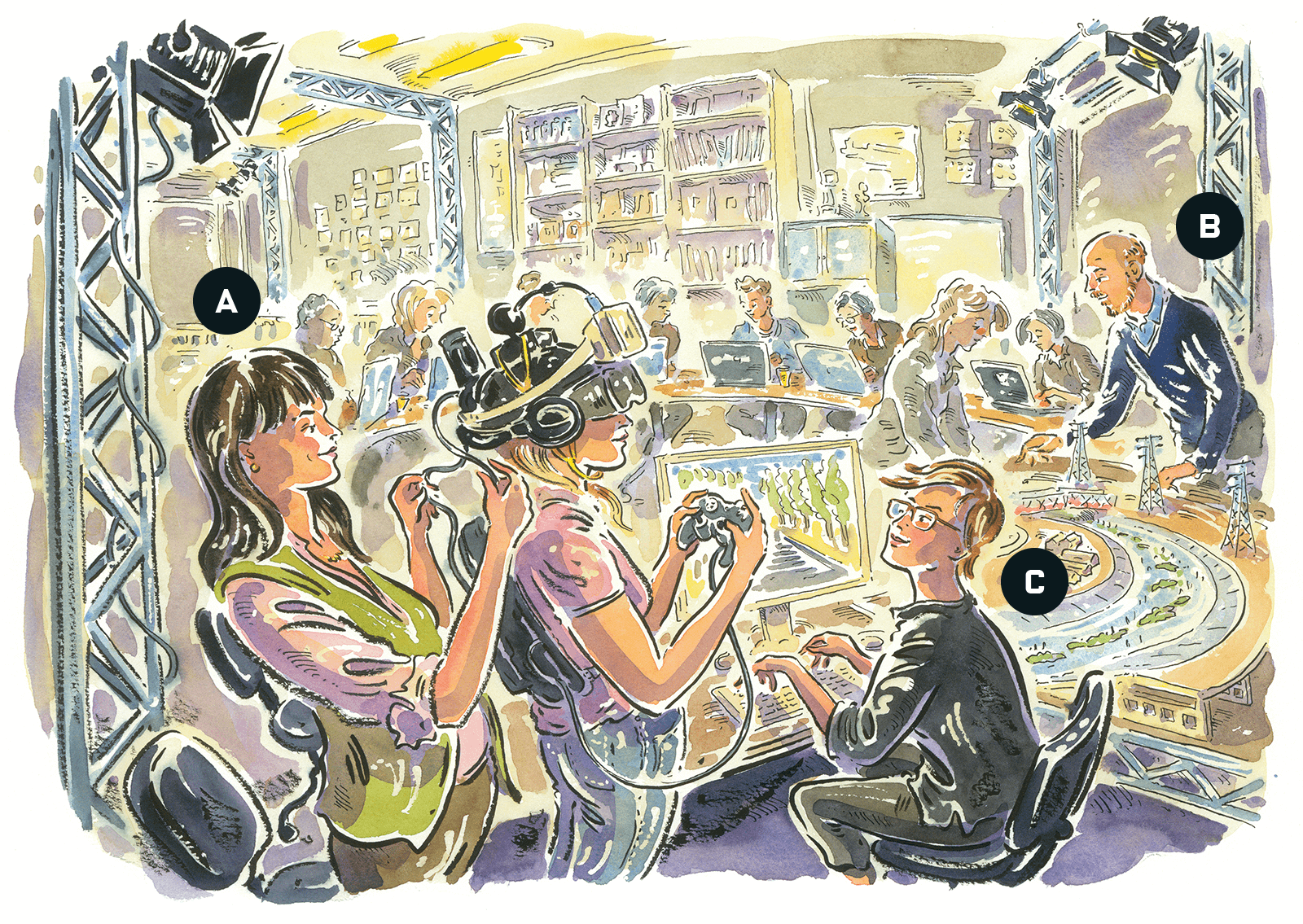
A) Marientina Gotsis, Professor of Cinematic Practice at Interactive Media & Games and Media Arts + Practice (USC Cinema)
“Computing research generates essential tools and methods for creating, imagining, storing, distributing, viewing, listening, feeling, thinking, sharing, archiving, processing, analyzing and collaborating to help us dissolve borders between disciplines and geographies. While I am a fine artist by training, my advanced computing skills are what enable me to cross sectors.”
Gotsis, who runs the USC Creative Media & Behavioral Health Center, uses off-the-shelf technologies, such as game engines, VR headsets and body sensors, but also experiments with emerging technologies, such as generative AI, neurotechnologies and wearables.
She and her interdisciplinary collaborators have done pioneering research in mobile health games with the USC Wellness Partners study — one of the first socially networked “gamification” exercise interventions — before the proliferation of social media and smartphones and several “exergames” for sensorimotor rehabilitation for patients, including “Skyfarer” for spinal cord injury and “Wordplay” for Parkinson’s. Both exercise games have been evaluated by physical therapists and patients, who found them to be motivating and helpful. The CMBHC-affiliated teams also used stereoscopy and extended reality technologies to develop educational experiences for children and families, teaching about vision health (“Enchanted Garden”) and nutrition (“Virtual Spouts”).
B) Alexander Robinson, Associate Professor, Landscape Architecture Program and Urbanism Program (USC Architecture)
“In my work on nature-based landscape infrastructure, computing is a fundamental tool for understanding, communicating and ultimately designing these complex landscapes. I employ it extensively for community outreach, field studies and hydraulic modeling on the Los Angeles River.”
Robinson’s research currently focuses on the Los Angeles River, which he has studied since working on the award-winning Los Angeles River Revitalization Master Plan. At the Inclusive Infrastructure Design Lab, he collaborates with faculty in the USC Viterbi School of Engineering (Mitul Luhar and Gale Lucas), USC Cinematic Arts (Andreas Kratky) and USC Dornsife Public Exchange, as well as the City of Los Angeles Bureau of Engineering and the United States Army Corps of Engineers. Recently, they presented a 60-foot-long model of the river’s flow that demonstrated different scenarios of potential flooding and how these floods would affect the L.A. environment, including people experiencing homelessness.
Furthermore, they are using computing to conduct frequent analytical field studies, largely with drones. With a closer understanding of the rapidly evolving urban environment, they open the door to more nature-based solutions. Finally, they also employ USC-developed real-time, numerical modeling to accelerate the design process.
C) Alexis Wellwood, Professor of Philosophy, Linguistics and Psychology (USC Dornsife)
“With the incredible advances in linguistic ability demonstrated by generative AIs, foundational research into the nature of human language is more important than ever. To what degree are human beings similar to computers, and in what ways are we different? I study human language as a cognitive capacity through the lens of formal semantics, a discipline with roots in philosophical logic and the foundations of computer science. Computational concepts like abstraction and the composition of functions are utterly critical to properly characterizing linguistic states and processes. In the Dornsife Meaning Lab which I direct, we conduct online experiments with children and adults using state-of-the-art computational methods to analyze and model the data.”
How natural languages “package” meaning can look very different across languages, but Wellwood’s research has provided strong, convergent evidence that this variation masks significant and fundamental similarities. She has shown that the same highly specific patterning in adult understanding of the word “more” and its cognates across languages, like “más” in Spanish or “plus” in French, is already grasped by children just entering preschool. This work, geared toward helping us formalize the properties of distinctively human thought, is receiving increasing interdisciplinary recognition across philosophy, linguistics and cognitive psychology.
7
Quantum Science and Engineering
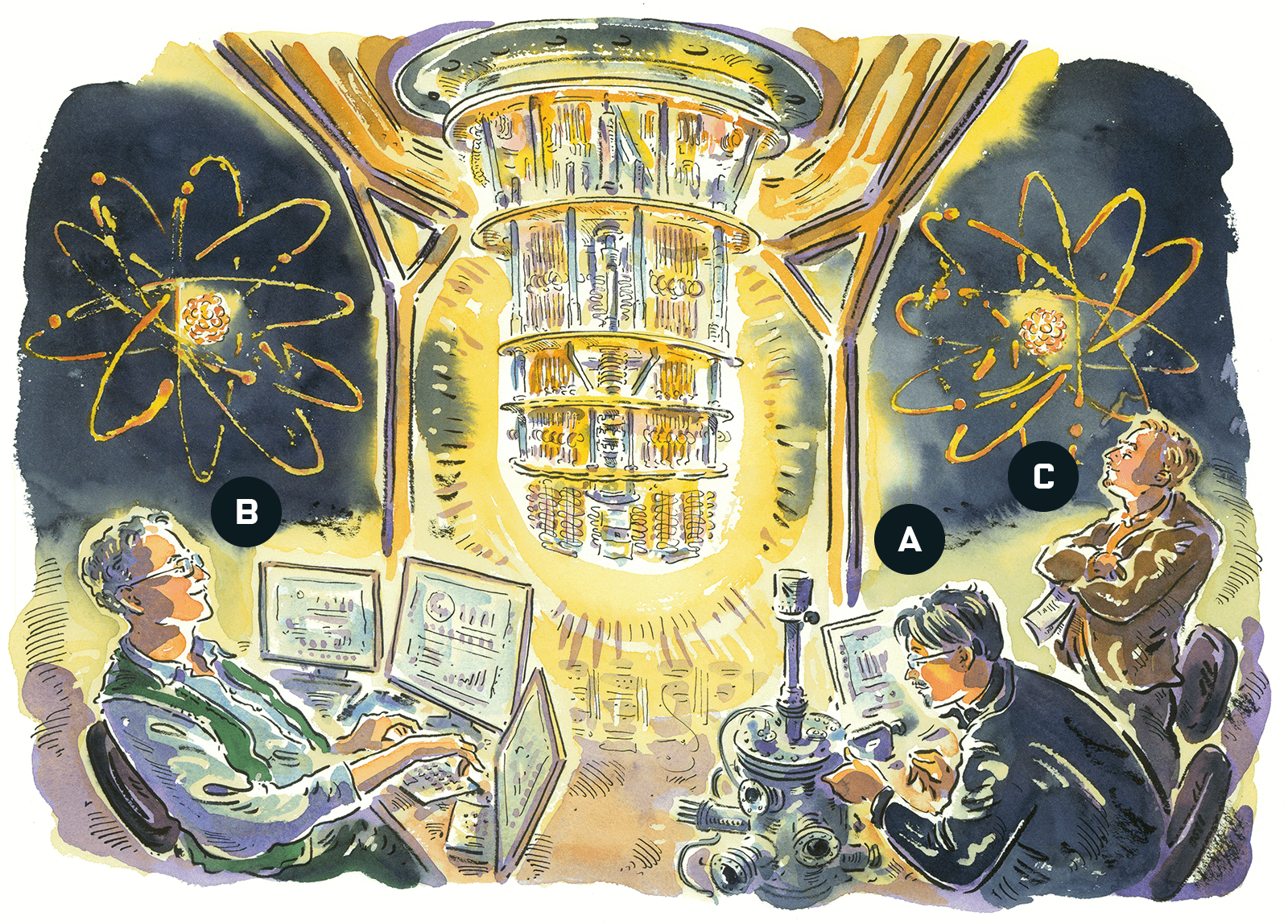
A) Susumu Takahashi, Associate Professor of Chemistry and Physics and Astronomy (USC Dornsife)
“The foundation of quantum computing is the key to various quantum information technologies.”
His research uses the basics of quantum computing for high-sensitivity physical measurements. In 2011, using high-magnetic fields, Takahashi and his colleagues managed to suppress decoherence, one of the key stumbling blocks in quantum computing. Decoherence has been described as a “quantum bug” that destroys fundamental properties that quantum computers would rely on.
His team has improved the sensitivity of the magnetic resonance spectroscopy to the level of a single molecule using quantum sensing technology. Takahashi’s interdisciplinary experimental research group overlaps in the areas of physical chemistry, quantum information science and condensed matter physics.
A former Hitachi semiconductor engineer, Takahashi now collaborates with Trojan engineers like USC Viterbi’s Stephen Cronin. They recently received the Zumberge Preliminary Studies Research Award for “Development of Bright and Stable Diamond Quantum Emitters for Quantum Sensing Applications.”
B) Daniel Lidar, Viterbi Professorship in Engineering and Professor of Electrical and Computer Engineering, Chemistry and Physics and Astronomy (USC Viterbi)
“Quantum computers have the potential to solve problems that are currently impossible for classical computers, like simulating complex chemical reactions or breaking modern cryptographic codes.”
A variety of factors can cause errors, or noise, including heat, the presence of magnetic fields or imperfections in hardware. Making quantum computers faster and better able to solve increasingly complex problems requires advanced noise suppression. One way to achieve this is encoding information in a single qubit (a unit of information in quantum computing) across multiple physical qubits. This achieves redundancy, so if an error occurs, it can be detected and fixed without the original information being lost. The same principle applies to telecommunications.
Lidar and other researchers are pushing the known boundaries on demonstrating the ability of quantum computers to speed up calculations.
For example, in 2023, he and his former graduate student Bibek Pokharel, currently a research scientist at IBM Quantum, demonstrated the first unequivocal algorithmic quantum speedup advantage. Using a 27-qubit IBM Montreal Quantum chip, and with the help of error-suppression methods they developed, they showed that the quantum computer could win a “Jeopardy!”-like game: It correctly guessed secret strings of bits faster than the most efficient classical computing algorithm, with an advantage that became more pronounced the longer the bitstring was.
C) Stephan Haas, Professor of Physics and Astronomy (USC Dornsife)
“Computing is essential to the fields of quantum science and engineering because understanding quantum phenomena requires the modeling of complex, interacting particles in quantum systems, such as electrons in superconductors. These models are often highly intricate, and their properties can typically only be uncovered through advanced computational methods, such as Quantum Monte Carlo. Additionally, emerging quantum computing technology enables us to simulate dynamic processes in interacting quantum systems. For instance, at our Quantum Innovation Center, we utilize the IBM quantum computer to explore these processes.”
His group integrates computing with quantum science by employing advanced techniques like renormalization group, Quantum Monte Carlo, and exact diagonalization to investigate many-body systems in fields such as quantum magnetism and superconductivity. Notable accomplishments include applying the Stochastic Series Expansion Method to study quantum spin liquids and developing optimization algorithms for nanoscale optoelectronic devices. Haas’ team also explores quantum dynamics and topological systems, contributing to the understanding of noise-assisted tunneling and hybrid topological phases.



